The Challenge of Facility Data
Facilities are complicated, with multiple “dimensions,” each of which has different measures and metrics. You have a wealth of facility related data, scattered among various systems: a finance system, maybe another for plant assets, a work order system/CMMS, one or more BMS/BAS systems, a CAFM system, and some spreadsheets with other information. Increasingly facility systems are outside your organization in the cloud or with a service provider
These systems are good for their purpose – operations. But integrated data is required to see beyond the day-to-day. Some of the challenges this presents to facility leaders are:
- “Swivel chair” integration when you jump from a screen on one system to a screen on another.
- Two different answers to the same question such as different GSF for the same facility from different systems.
- Difficulty in quickly finding an answer because the data is not readily available.
- The need to manually create one-time spreadsheets or documents to assemble the data you want for a specific purpose, along with the time and effort to do so.
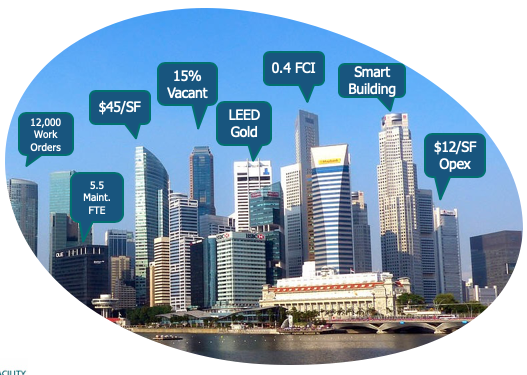
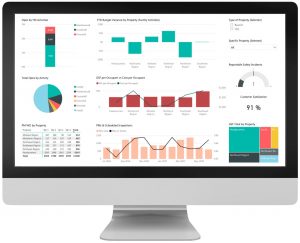
The Value of Integrating Metrics in Facility Management Dashboard and Scorecards
Because of the varied data and multiple systems associated with our facilities, we need to combine and simplify the metrics to gain insight from our FM data. There are a number of technical ways to assemble and integrate data, but the details of those are not important for this discussion.
The key point is that integrating your facility management metrics in a single set of scorecards provides some specific benefits:
- One “stop to shop” for facility data (quicker to reference, quicker to find commonly used data, quicker response to ad-hoc questions).
- Easier & less expensive than integrating systems (just integrate the metrics and use the systems as they are).
- Easier access to data/systems that are outside your firewall.
- Easier to put facility metrics in business terms (business metrics are not typically in FM systems).
- More robust analysis, models, and forecasts are possible (able to see metrics that cut across different systems, can support strategic planning).
The Differences Between Facility Management Dashboards And Scorecards
The terms Dashboards and Scorecards are often used interchangeably, but for our discussion here we are going to distinguish between them based upon their purpose. (You can call them whatever you wish in your organization.)

Facility Management Dashboards are operationally focused tools (how we keep this ship running properly). They contain sets of measures that are used to guide facility operations, usually in real time such as: equipment status, pressures, and work order status.
Good dashboards present a limited amount of measures in an intuitive way – just those items needed by the user. They need to be quickly and easily understood to allow appropriate action even when the user is distracted. An auto dashboard is a good example of this as those designs have evolved over time.
For facility management, most dashboards belong with your various data systems (Building control systems, work order systems) to support the intended function of that system for those users.

Facility Management Scorecards are strategic managerially focused tools (how are we doing on our voyage). They contain sets of metrics, some of which may use data from multiple operational systems such as: cost per GSF, percent of maintenance completed on schedule, and energy use per occupant.
Unlike dashboards, scorecards can include the broad picture of your facility asset and/or operations with the full range of facility metrics. They also do not need to be real time to be useful. To make them more usable, you can group facility metrics by category and have summary items with drill-down for detail.
Facility management scorecards range from a manually updated Excel file to a business intelligence platform, but are not likely to be within any of the facility systems you have.
A scorecard(s) can let the appropriate people easily identify what information is important for their purposes. Ideally this will be as automated as possible and allow you to add and subtract data from systems as you adopt new technologies or upgrade your current systems.
Organizing Your Metrics on Facility Management Dashboard and Scorecards
We discussed how facility metrics correspond with the key roles in facility management. So, you will want to organize your scorecard(s) in a similar way to support your data driven decisions.
Some of the metrics you identified and defined in the prior step can exist in a “silo” (e.g. work order completion) while others are dependent on measures or metrics from two or more different functional areas (e.g. cost per completed move).
Here are some tips when developing your integrated facility management scorecard approach:
- Relevant to the user: Consider your scorecard to be a set of pages, one designed for each user role. You may have separate documents/systems making up your scorecard depending upon your organization and underlying systems.
- Don’t duplicate: If your functional system has a good dashboard for a given user role, just use that as a “page” and roll up the metrics into your integrated scorecard for other roles.
- Drive desired behavior: The metrics on the scorecard should be ones that measure performance with respect to defined goals or that are useful in guiding action to accomplish defined goals.
- Understandable: The metrics should be intuitively understood and of interest to the intended user.
- Use good data: Key measures should come from the agreed system of record for that topic (e.g. actual costs from accounting, not CMMS).
- Balanced: Some metrics are useful in combination to ensure that performance is in balance – not cutting cost corners at expense of quality.
- Useful or necessary metrics: The reason to have a scorecard is to provide useful metrics. (Earnings per share is a good corporate metric but not very relevant to a building engineer. It is okay to share general metrics, but they should be on a separate overview report/page.)
- Timely: Most reporting needs to be monthly to be of value, but some items may be available/relevant at different frequency.
- Use hierarchy for visual simplicity: Display design needs to group items and organize them by topic or with drill-down to avoid clutter and make the display easy to read and understand. Avoid using superfluous graphics (which reduces our ability to perceive the scorecard content).
Example Facility Management Dashboard and Scorecard Uses
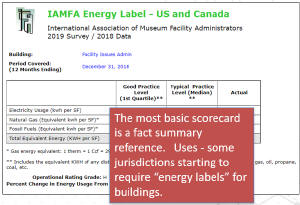
Facility “Fact Sheet” – Your scorecard can include a “report” in a standard format that needs to be published on a regular basis for internal use, regulators, or customers.
Status at a Glance – Your scorecard can summarize the values of a number of metrics/KPI’s to provide a quick overview of the situation.
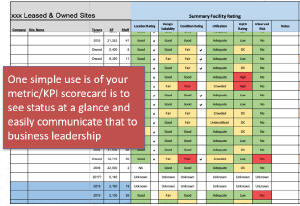
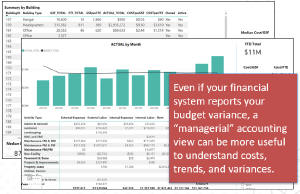
Monthly Variance Reports – Your scorecard can include comparison of actual vs. budget (costs) and actual vs. target (sustainability metrics) in a “managerial” view that is useful to understand facility performance.
Benchmarking – Your scorecard data can directly feed your facility benchmarking input and include comparison as part of your variance reports.

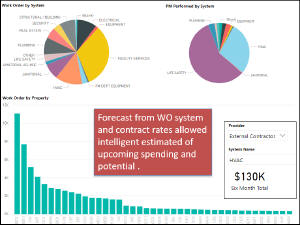
Analyze Trends – Your scorecard can summarize work order status and compare it with occupancy rates and service compliance. Trends can be used to project selected spending for mid-year budget adjustments.
Forecast Likely Needs and Budgets – Your scorecard can forecast space based on different scenarios to identify likely needs and associated investments and operating budgets, or alternative measures.
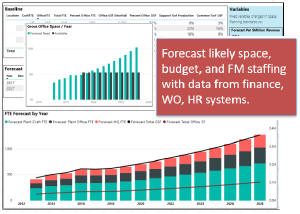
Use facility management dashboard and scorecards for a single view of key facility metrics. Your facility data can be a valuable resource. Use your metrics to stay on track, make timely course corrections, forecast trends, and enable data exploration that provides strategic insight.
Facility Metrics & Scorecards
Facility Issues can help you identity metrics of value and setup your custom facility scorecard that does not need new software or a dedicated analyst.
